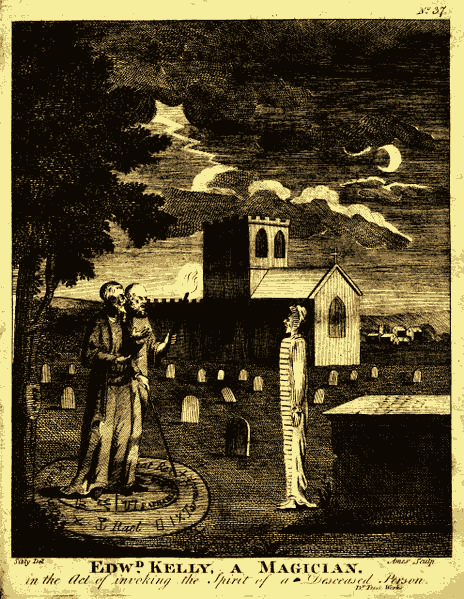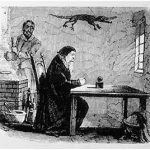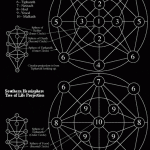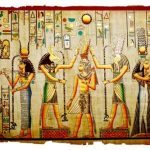The discovery of the planet Neptune in 1846 functions as a convenient reference point. Neptune is the planet of the mass mind created by technological advance. As such, its discovery heralded the dawn of a new era, the age of popular culture.
Within two years, populist revolution, fed by newsprint and a literate underclass, would sweep Europe forcing its liberalization, and another revolution, this one with spiritual implications, would sweep through the drawing rooms of the middle and upper classes around the world. The spirits of the dead seemed to have returned and demanded a dialogue with the living. Astounded, organized religion went mute in the face of the miraculous. The dialogue, taken up by an enormous variety of voices through the years, created a type of experiential spirituality unknown since antiquity.
And it all started in America.
***
Hydesville, New York, in the spring of 1848, was a sleepy little township not far from Rochester. A Methodist farmer, James D. Fox, had recently moved his family into a small frame house on the outskirts of town. The previous tenant had been disturbed by various loud knocks for which he could find no cause. The Fox family were also bothered by banging and thumping sounds that kept them awake at night. They were not overly concerned. The house was old and it was a windy March.
On Friday, March 31, the family went to bed early. Before retiring, Mr. Fox checked the shutters and sashes, and the children, particularly the two girls Margaretta 14, and Kate, 12, noticed that the knocking seemed to echo Mr. Fox’s random shutter banging. When the knocks started again in the bedroom, Kate called out “Mr. Splitfoot, do as I do,” and snapped her fingers. The raps immediately imitated her. Margaretta tried it, saying “Do as I do” and clapped. The sounds imitated her claps.
Mrs. Fox, eager to end the prank, asked a question of the spirit. “I then thought I could put a test that no one in the place could answer. I asked the noise to rap my different children’s ages, successively. Instantly, each one of my children’s ages was given correctly, pausing between them sufficiently long to individualize them until the seventh, at which a long pause was made, and then three more emphatic little raps were given; corresponding to the age of the little one that died. . .” Truly frightened, Mrs. Fox asked the big question: “Are you human?” No response. “Are you a spirit?” Two thunderous bangs, loud enough to shake the house, was the reply.
The dialogue had begun. The Foxes called in their neighbors as witnesses, and one of them, William Duesler, took up the questioning of the spirit. Establishing a code of knocks, it was soon learned that the spirit was a man who had been murdered in the house five years earlier, a peddler by the name of Charles B. Rosma. A maid of the former tenant, a Mr. Bell, reported that a peddler had spent the night at the house, as the spirit said, and had either left or disappeared under suspicious circumstances.
Imagine for a moment the scene. Late into a blustery spring night the small house, filled with anxious and frightened neighbors, resounds and shakes with the intensity of the dead peddler’s communication. The crowded bedroom, lamps and candles flickering with each drafty blast and ghostly thump, fairly crackles with the tension. Gasps and cries of reassurance sweep through the rooms full of curious onlookers as rap by the rap the story emerges. The dead have returned to tell their tale. To these Bible drenched Methodists, it must have seemed like a portent of the end of the world.
In the days following the first manifestations, a committee of local citizens formed to collect the statements of witnesses. Not everyone was convinced that the phenomenon was supernatural. Yet no one quite suggested that it was a hoax or that the Fox family was responsible. It was soon noticed that nothing happened unless the children were in the house. Three committees investigated without finding any fraud or coming to any reasonable conclusion how the sounds were produced. They searched the girls for devices, then made them stand on pillows with their ankles tied. The knocks and raps continued.
The children were separated, sent to stay with older siblings in different towns. The spirits followed both of them and the manifestations continued. Rapping noises were heard and invisible hands brushed people and threw things. Interestingly enough, these spirits had nothing to do with the old peddler; he was back at the Hydesville house making terrible gurgling noises punctuated by the sound of a body being dragged across the floor. Mrs. Fox’s hair turned white from the strain. At sister Leah’s house, Kate was now conversing with a dead relative. Soon Leah discovered her own mediumistic ability, as did another girl who visited Margaretta in Auburn.
This points to the most curious aspect of the phenomenon: it seems to have spread much as a bacterial or viral infection does, by contact. Visiting a medium and being exposed to the phenomenon produced a reaction in certain sensitive individuals; they became mediums themselves. Spiritualism developed like an epidemic, spreading from parlor to parlor as more and more people were exposed.
The Fox family, reunited, moved to Rochester. The spirits again followed, and so the sessions continued. One day a visitor began to ask a question but was suddenly interrupted by a barrage of knocks. By means of an alphabetic code, the spirit tapped out a message: “Dear friends, you must proclaim this truth to the world: This the dawning of a new age; you must not try to conceal it any longer.” The message ushered in a new wave of manifestations. Tables tipped and tapped out messages, musical instruments played by themselves and ghostly objects floated around the room. The believers heeded the spirits’ call to proclaim this truth. The first Spiritualist meeting took place on November 14, 1849, at the Corinthian Hall in Rochester. In the next year, over a hundred mediums appeared in the Rochester area alone. A local contemporary historian, M.A. Richardson, remarked: “Were we to draw an inference from the number of cases of reported visitation from the invisible world that have been made public of late, we might be led to imagine that the days of supernatural agency were about to recommence, and that ghosts and hobgoblins were about to resume their sway over the fears of mankind.” This ghostly eruption had been predicted by a young American shoemaker, Andrew Jackson Davis, in a book written under hypnosis and published in 1847. He announced that “the truth about spirits will ‘ere long present itself in the form of a living demonstration, and the world will hail with delight the ushering in of that era when the interiors of men will be opened.”
By 1850, spiritualism had spread to England and the continent of Europe. Even Queen Victoria and Prince Albert tried it. The table moved so convincingly that the Queen had no doubt of the phenomenon’s reality. She speculated that animal magnetism or some form of electricity must be involved. Later, after the death of Prince Albert, the Queen would turn to spiritualism for comfort and guidance. On the continent, the French, with their experience of Mesmer, agreed with the Queen’s assessment and embraced the phenomenon enthusiastically.
*****
Dee and Kelly were simply ahead of their time. They would have been much more successful in the nineteenth century. Indeed, it is a French convert to spiritualism that most reminds us of Dr. John Dee. A celebrated educator, the fifty-year old Denizard Hyppolyte Leon Rivail, discovered automatic writing in the summer of 1855. In the trance produced works of two sisters, Rivail recognized an impressive inner consistency. He asked his friends for more automatic material and received over fifty notebooks. From this, he produced The Spirits’ Book, which became a classic of Spiritualism. The message of this book from the spirits — that man is a spiritual being whose destiny is to evolve towards perfection — matches that of Dee’s “Radical Truths.” Dee would certainly have approved, and been astonished at the book’s popularity. In 140 years, it has never gone out of print.
If mathematician Rivail echoes Dee, then it is in society wizard Daniel Douglas Home that we find a reflection of Kelly. Home, born in Scotland of a Highland “seer” and an unknown father in 1833, seems to have grown up with the phenomenon to become its most extravagant example. At age nine, he moved to America with his aunt. Daniel was a sickly child, the model of the “sick sensitive” type prone to mediumship. A boyhood pact — whoever died first would contact the other — with his friend Edwin bore fruit in the summer of 1846 when Home was thirteen. Edwin appeared to young Home and drew three circles in the air, indicated that he had died three days before. This proved correct.
Four years later, Home had another vision. This time it was his mother who had died. Soon he was being harassed by the usual knocks and rapping, which caused his aunt to throw him out. He became a medium, looked after by the spirits and kindly acquaintances as he wandered through New England. With everyone in the United States, it seemed, talking about spirit communication, Home could hardly have chosen a better time to launch himself on the world.
Or perhaps the spirits chose it for him. Home would never claim any credit for his incredible feats. It was all the doings of the spirits. Later, they even stripped him of his powers for a year. Objectively, it looks as the spirits were using Home to make a point or communicate a message.
What could that message have been? Why table turning, levitation, talking with the dead, materialization and the rest of Home’s conjuring tricks? Nathaniel Hawthorne, visiting Florence a few years after Home, collected dozens of accounts of Home’s phenomena and observed that “these soberly attested incredulities are so numerous that I forget nine tenths of them. . . they are absolutely proved to be sober facts by evidence that would satisfy us of any other alleged realities; and yet I cannot force my mind to interest itself in them.”
With this comment, we come face-to-face with the basic problem of spiritualism. In the antics of Home, the Fox sisters, the Davenport brothers and all the other Victorian mediums we encounter nothing of any intellectual depth, except the experience itself. No information of substance was transmitted by the spirits, with the possible exception of Rivail’s The Spirits’ Book. When asked why he wouldn’t attend a seance, T. H. Huxley, the very model of a Victorian major scientist, exclaimed, “If anyone could endow me with the faculty of listening to the chatter of old women and curates in the nearest cathedral town, I should decline the privilege, having better things to do.”
The message then lies within the experience itself. Exposure to table turning and ghostly music and long dead Aunt Tillie’s travelogue of the Other Side creates a shift in consciousness, minor in most people, but so radical a shift in some that they become capable of producing the phenomenon themselves. The banal quality of the information offered by the spirits assured the indifference of those who had not had the experience. To the person attending a seance, it is not what Aunt Tillie has to say so much as the fact that Aunt Tillie is communicating at all.
The spirits, seemingly, made a vast and concentrated effort to convince the Victorian public of their existence. It failed, for the most part, among the scientist and intellectuals and other leaders of public opinion. They attempted to destroyed spiritualism by ridicule — which wasn’t hard considering spectacles such as that of the Davenport Brothers doing vaudeville turns in between jugglers and dog acts — and when that didn’t work fell into a sullen silence. It was obvious that Victorian science, like organized religion, had no explanation for the phenomenon.
If, to quote McLuhan, the medium is the message, then what did this outbreak of spirits actually signify? The discovery of Neptune marked the emergence of a new kind of mass consciousness just at the moment when the breakdown of old perceptual models, such as Christianity and the one-pointed cultural perspective of the Renaissance, left western consciousness in dis-order, or chaos. During this “midnight” of materialism, there occurred a primary rediscovery of the unconscious fueled by spiritualism’s eruption of phenomena. This rediscovery happened at a popular level, in a moment of individual experience. It was not guided by dogma or orthodoxy but by the internal logic of the phenomenon itself.
Herein lies the importance of spiritualism. The intrusion of the spirits distorted the hard-line edge of material reality. Vast perceptual gray areas suddenly opened up in the collective unconsciousness. These areas of miraculous possibilities were soon filled with the shadowy projections of the public’s hopes and desires. Victorian scientists, such as Huxley, were fixated on the external; their consciousness diffused through the material realm like Blake’s image of Newton drawing diagrams at the bottom of the ocean. Even when exposed to the phenomenon, they proved for the most part to be immune. The scientists who did happen to become interested, and there were more as time went on and the evidence continued to mount, often ended merely trying to pin a label — such as fraud, bio-electric telekinesis, etc. — on a phenomenon that ingeniously defied definition.
More Articles from Sangraal.com:
Submit your review | |








